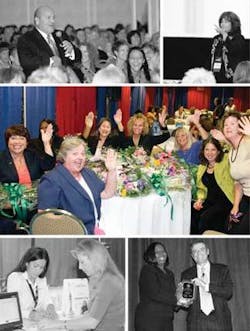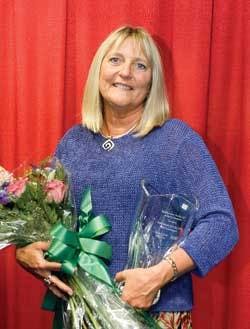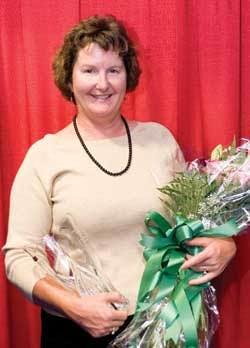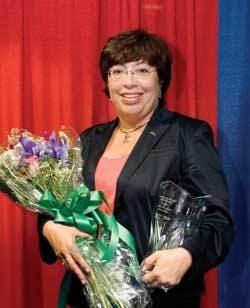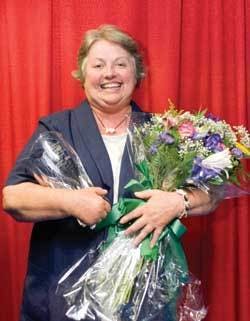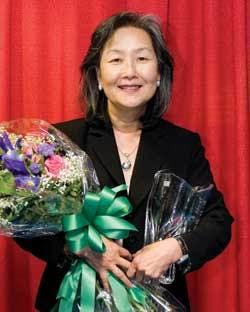The Sixth Annual Healthy Gums. Healthy Life. Award of Distinction
by Cathleen Terhune Alty, RDH
A dental hygienist from the Marshall Islands is among the eight recipients of the Sunstar/RDH magazine G.U.M. Healthy Gums, Healthy Life Award of Distinction.
Eight fabulous dental hygienists received the 2007 Sunstar/RDH magazine G.U.M. Healthy Gums, Healthy Life Award of Distinction at the RDH Under One Roof conference in Washington, D.C. in August. The eight winners were either nominated by a colleague or composed an essay about the differences they make by helping patients enjoy healthier lives, sharing the unique steps they take to ensure patient compliance with their treatment strategies, and how they serve their communities through charitable efforts.
This elite group of veteran hygienists have been practicing for an amazing 232 years combined and an average of 29 years apiece. Far from being tired, washed up, or ready for a retirement rocking chair, these women still have big dreams for their careers and want to contribute to the next generation. They each serve as an inspiration to all who wear the title of dental hygienist and want to make a difference in their profession.
Sunstar Americas produces the G.U.M. and Butler oral care products. The company’s U.S. headquarters is in Chicago.
Sandra Sacks Berger, RDH, BS
Freehold, New Jersey
“Never be satisfied with just ordinary”
Sandra in one word: Resourceful
Best decision she ever made: “Not to cancel my second date with my husband. He asked me for another date at the end of the first and I couldn’t think of a ‘no’ answer quickly enough at the time. All week I wanted to cancel, but I didn’t.”
What keeps her awake at night: “A good book, unfinished things, thinking of tasks I need to do the next day.”
Sandra graduated from Ohio State University in 1979 with her dental hygiene degree and then in 1980 with a bachelor’s in education. Of her 28 years in practice, 24 of them have been at the same dental office! Sandra is passionate about patient education. She has been the program coordinator of the Jersey Coast Dental Forum, a Seattle Study Club for the past seven years. Sandra also organizes the “Hygiene Extravaganza,” the largest meeting of its kind in the New York, New Jersey, and Pennsylvania area.
Noel Kelsch, RDH, who nominated Sandra for the award, wrote, “She goes a step beyond to learn every aspect of patient care and education and apply it to each patient, learning their needs and meeting them with the information she finds,” writes Noel Kelsch in her nominating essay. “She is always sharing cutting-edge information on subjects from periodontal treatment to new methods for treating caries.”
Sandra creates information sheets for her patients, writing individual instructions down so they will remember. She also follows up with the patients’ health-care provider when dealing with systemic health issues. Sandra also volunteers at many community events and presents preschool and elementary school programs for children’s dental health month.
Her career plans include earning her master’s degree, corporate event planning, organizing and research.
Five Tips For Patient Compliance
Sandra Sacks Berger, RDH, BS
1. Write everything down, clearly, and in layman’s terms. I’ve read that people retain only 20 percent of what they are told verbally. They can’t comply if they don’t remember what you recommended.
2. Make sure the products you want your patients to use are readily available. Give them the product or samples whenever possible. Many of my patients are elderly and may have access to only one supermarket or drugstore so I visit the stores and make sure they have what I like to recommend.
3. Be positive! My college professor once said, “In a mouth full of 160 surfaces, you have to find one that is clean. Focus on that one and the others will follow!”
4. Listen to your patients carefully. Review the health history at every visit, ask questions, and be interested. You can learn a lot about a person this way and will then be able communicate in a way that is more effective.
5. Don’t give up! If you have been introducing a new home-care technique or explaining their need for restorative work for many appointments and they have not yet complied, say it differently but continue to say it. You’ll never know when what you say or how you say it will ‘click’ with a patient.
Linda Bohacek, RDH
Eau Claire, Wisconsin
“Advocate for public dental health”
Linda in one word: Dedicated
Best decision she ever made: “Receiving my education degree. That opened other doors and opportunities”
What keeps her awake at night: “Hardly anything. When I hit the pillow, I am out!”
Linda is described as an oral health pioneer in her community, since no programs for children existed in her community before she got involved. She established a program that provides oral examinations, risk assessment, education, fluoride varnish applications and referrals to a dentist as well as starting a school-based sealant program.
Sarah Pedersen, RDH, CDHC, is a fellow Eau Claire resident. Pedersen nominated Bohacek for the award and wrote, “If this program were not in existence, 22 percent of the children would still have untreated dental disease.”
Linda’s volunteer activities in the community have created more support for her oral hygiene programs. She is a member of the Head Start Health Advisory Committee, Healthy Communities 2010 Advisory Council, and the Wisconsin Dentistry Examining Board. She is also a member of the advisory committee for the Chippewa Valley Technical College dental hygiene program.
Pedersen adds, “She has persuaded the college to allow the students to volunteer at the school-based dental sealant sites and the Head Start sites as a means of exposing the students to public health initiatives.”
Linda says, “I truly love what I am doing now and am passionate about the work that I do. I would like to be a mentor to others who are thinking about public health dental hygiene.”
Five Tips For Patient Compliance
Linda Bohacek, RDH
1. Become an active listener. Identifying a need is paramount in determining how to best move forward with activities that will ultimately support oral health. Active listening involves making eye contact and reiterating what the patient has just said so as to make sure one understands correctly.
2. Establish trust. Engage in a dialogue with clients that supports your willingness to become a partnership in decision-making. Sometimes patients need emotional support and such a simple thing as saying you are there for any questions that they may have can go a long way in changing behaviors.
3. Engage the patient in a hands-on activity. Confucius said, “I see and I forget. I hear and I remember. I do and I understand.” Language and cultural barriers can be overcome by using this technique. Having the patient actively demonstrate learning through an activity allows me to evaluate how information was received. It also allows me to see that the patient can physically perform the task.
4. Have options available. Including the patient in decision-making is important for “buy-in”. For example, when introducing oral health aids, give the patient choices. The most important aspect of patient compliance is to allow for client choice.
5. Identifying sound research documents, and trying new products and technology are important for credibility when answering clients’ questions. The Internet has placed us in a position where we must be ready and prepared for questions.
Diana Corbin, RDH
Sperryville, Virginia
“When you start giving back you feel so good you want to give more”
Diana in one word: Energetic
Best decision she ever made: Becoming a dental hygienist. “I applied to Ringling Brothers and Barnum Circus Clown College at the same time I applied to dental hygiene school. My mom said, ‘You’d better study hygiene.’ She was right!”
What keeps her awake at night: “I wish I could say how to solve the dental decay in children or stop periodontal disease, but it’s deeper than that.”
Diana has a heart for people who are not getting the dental care they need. From her experiences volunteering on dental screenings and working with the Virginia Department of Health, she sees the problems associated with patients who need care but lack insurance. “For a long time, I have felt dental care is a luxury for most budgets. When they don’t have dental insurance, dental treatment is something people do without. The consequences are tremendous. Usually the treatment of choice is tooth extraction because any other treatment is too expensive.”
Diana builds good relationships with her patients so they will listen to her recommendations.
Diana’s future plans include developing a way for underserved adults to get free dental hygiene services, and maybe moving to Montana or Wyoming.
Five Tips For Patient Compliance
Diana Corbin, RDH
1. I have found making a real connection with each patient and making them feel important is essential to good patient compliance. If they feel you really care about them as a person, rather than a body they will try to do better even if its just for you.
2. I always find out where they are with their knowledge. I am amazed how many people don’t know to brush twice a day or to brush their tongue. If you tell them and slowly build their skills and habits most of the time they will improve.
3. I have found if the patient knows the need for why we are asking them to improve their homecare they usually comply. Benefit sell them, I use everything. I talk to them about bad breath, if you suggest teeth whitening and show them how using an electric toothbrush which will help to remove stain better and it also help with their brushing technique and therefore improve their plaque removal.
4. I am a firm believer in continuing education and staying involved in our professional organization. Attending classes and having an opportunity for networking with your peers helps keep you motivated and enthusiastic
5.Keeping up with new techniques and new products are fun and useful. You have to be willing to change and try new things,we become to much a creature of habit and reluctant to do something new or different. There have been so many changes and advancements in dental health and we and our patients can benefit from them. If we just let ourselves embrace the benefits.
Cynthia M. Dixon, RDH
Houston, Texas
“Knowledge is power.”
Cynthia in one word: Committed
Best decision she ever made: Attending dental hygiene school
What keeps her awake at night: “Not many things keep me awake at night besides making sure our daughters are home and safe. Other than that, I try not to worry about things I have no control over.”
Cynthia graduated in 1984 from Texas Women’s University in Denton, Texas. She has worked in both private practice and public health, creating programs and coordinating services, including a “district wide program of distributing toothbrushes and educational tools to teach students home care.”
Cynthia is keenly aware of the need to educate patients. “I know it is my responsibility to teach my patient the important relationship between dental health and total physical health, especially cardiovascular health.”
Cynthia often uses visual techniques to allow patients to better see what she wants them to understand. “My favorite visual tool is the microscope,” she said. “I take a scaler and remove plaque from the patient and prepare a slide. I can show the patient the bacteria growing in the plaque from his or her own mouth. This is extremely effective, especially with school-aged children.”
She is a regular volunteer and active member of many organizations and has received numerous awards for her willingness to give her time and expertise.
Her career plans include possibly teaching dental hygiene and starting a mentoring program for dental hygiene students.
Five Tips For Patient Compliance
Cynthia M. Dixon, RDH, BS
1. Be an example for the patient - A positive approach is the best way to gain patient compliance. I share my dental history and what I do to obtain dental health.
2. “Reach them young.” - Working for the largest school district in Texas, the Houston ISD allows me to reach students that are at great risk of dental problems due to lack of knowledge at home and lack of money for treatment. I created a district wide program of distributing toothbrushes and educational tools to teach students home care.
3. Maintain a patient-focused practice - I love to spoil my patients with massage chairs, hand waxing, and using a facial massage technique while assessing for oral cancer. I work to keep conversations focused on the interests of the patient, which allows me to know my patient better.
4. Be friendly, have fun - Your patient looks forward to their re-care visit, therefore they will be more likely to maintain a regular schedule. A friendly environment will encourage patient trust and success for the entire dental team. Humor is a great tool to encourage relaxation and these patients become our best referral source. I collect comic strips that poke fun at dentistry, and patients love looking for the new comics I have collected on return visits.
5. Encourage, don’t discourage - By focusing on possibilities for improving oral health instead of what is done incorrectly, you keep the “communication door” open. Often, I hear patients complain that they have been lectured or humiliated by hygienists. I encourage my patients to use simple and effective ways to maintain good oral health.
Donna Grzegorek, RDH
Algonquin, Illinois
“If I could save just one life, wouldn’t it all be worth it?”
Donna in one word: Passionate
Best decision she ever made: Choosing not to pursue dental school. “After many years of practicing dental hygiene with a dream to go to dental school one day, I came to the noteworthy conclusion that I would have a more significant effect on the positive health outcomes of my patients as a dental hygienist than as a dentist.”
What keeps her awake at night: “Nothing. After working a minimum of 12-13 hours a day, most days, I can honestly say I fall into bed at night proud of my accomplishments and completely exhausted from my effort.”
Donna has many responsibilities that keep her busy: full-time practitioner, speaker for the Academy of General Dentistry, COO of an orthodontic company, hygiene educator for two dental pharmaceutical companies, and mentor to fellow hygienists. Giving back to the profession she loves energizes her to do even more, including setting a Guinness World Record for the most number of people dental flossing on a single strand of floss (297 flossers, 1,500 feet of floss).
Donna has seen big changes in hygiene in her 27 years of practice. “I have observed the profession mature from that of mechanical tooth debridement to that of veritable health-care provider,” she writes. “As a hygienist, I have the wonderful opportunity and critical responsibility to counsel my patients on the importance of living healthier lives through meticulous oral healthcare.”
Donna plans to continue practicing clinical hygiene and take a more active role in spreading the message about oral cancer and the medical health benefits of optimal dental care.
Five Tips For Patient Compliance
Donna Grzegorek, RDH
1. Communication is critical - When my patient clearly understands the message, compliance is probable. Effective communication is a fine art, one that takes much practice. Patients learn visually, audibly, with proffesionally-written material, and/or homemade materials. I provide all of the above for every patient.
2. Continuing education - When a patient values my education and intellect they will comply with recommendations. Patients are informed that hygienists require 24 CEUs for license renewal. They knew I completed 174 CEUs during the last renewal. They accept me as a resource and are grateful for the commitment I make to my profession and their health care.
3. Invest in a patient’s medical health - I document personal appointments that patients have, such as mammograms, colonoscopies, sugar testings, EKGs, MRIs, rheumatologies or general physical exams. I contact the patient after such events. This small effort goes a long way to creating a friendship and noting my investment in their medical wellness.
4. Invite patients to speaking engagements - I invite patients to attend lectures I present and seminars I take. It reminds them that my commitment to my profession and their health care extends beyond the nine to five.
5. Calls to encourage better compliance - I call patients three weeks after SRP to inspire home-care compliance. I call after laser treatment, periodontal maintenance, and when necessary to schedule a three month re-care appointment. I call after they purchase a powered toothbrush, since the learning curve for using them correctly can be dispiriting. My personal touch conveys a caring message and reminds them of my expectations.
Millie E. Thaw RDH
Deer Park, New York
“If you don’t participate, you don’t have a voice.”
Mille in one word: Compassionate
Best decision she ever made: Being a mother
What keeps her awake at night: “It doesn’t take much to keep me awake at night. I worry about everyone and everything surrounding me.”
Millie Thaw works constantly to make a difference in her community and profession. Aside from being an active member of American Academy of Dental Hygiene, American Dental Hygiene Association, and Long Island Dental Hygiene Association, Millie is involved in the PTA at her daughter’s school and volunteers at her local synagogue. Millie says she has also mentored several hygienists through rough times in their careers.
Since graduating from Eugenio Maria de Hostos College in Bronx, N.Y., in 1979, Millie has worked to keep up her knowledge of current dental trends.
She said, “I explain to patients the correlation of various conditions such as diabetes and high blood pressure in regard to not only oral health but to their total body health.”
Millie prefers a personalized experience for her patients. “I treat every patient as an individual with individual needs and always take into consideration the patient’s socioeconomic and personal situations and treat them with respect. Every patient is treated as if they were a member of my family.”
Her career plans include getting more involved with dental hygiene education, becoming a speaker, and returning to school.
Five Tips For Patient Compliance
Millie E. Thaw, RDH
1. I schedule the patient’s next appointment while they are still in the operatory.
2. I give patients written home-care instructions and go over them verbally, and also send them home with a ‘no excuse’ goodie bag of enough dental items to last them until their next appointment.
3. I explain the importance of proper health (especially diabetes and high blood pressure) in terms that the patients will be able to understand.
4. I keep things on a personal level while talking to the patients, such as if they have children or pets. I will mention them in my discussion with the patients and personalize things. When they know I am interested in their life as well as their health, they are more apt to be compliant.
5. I feel that if ‘home care 101’ is not working that the patients should be offered other options and be involved in the decision-making - in particular, what type of home-care items they wish to use.
Judith Shimamoto, RDH
Marshall Islands
“Involve the patient with the process”
Judith in one word: Loquacious
Best decision she ever made: Deciding to go to college and deciding to have a personal adventure after my sons were grown. That decision led me to the Marshall Islands, which is where I am now.”
What keeps her awake at night: “Almost nothing.”
Judith has practiced hygiene for 35 years, most of them in the St. Louis area. But the last six years practicing in the Marshall Islands, a Micronesian island nation in the western Pacific Ocean. Judith says that living and working on a U.S. military installation has provided her with “the most rewarding outreach opportunities of my long career.”
She has been very involved in education and outreach both to the workers on the base and the Marshallese people, inventing clever ways to keep presentations from lapsing into the same boring thing every year. Judith has also been involved in bringing toothbrushes and health education to people on the nearby islands of Ebeye and Enniburr.
Judith writes that it is important to stay positive when educating patients. “I am careful to never berate, ridicule, or shame children or teenagers about ineffective home care. Stories I have heard from fearful adults suggest to me that similar tactics used on them in their past contributed to their dread of dental visits as adults.” Treating people with respect is her key.
Judith says, “At this point in time, what I’m doing and where I am are very satisfying. I have been given the opportunity to do good work. My plan is to enjoy this experience to its fullest.”
Five Tips For Patient Compliance
Judith Shimamoto, RDH
1. Don’t expect compliance. The word compliance suggests the patient is in a submissive role with me in a superior position. My relationship with my patients is not a dominant-submissive one but an equal one; together, we will find what works best for them to attain and maintain dental health.
2. Help the patient get comfortable and build trust. After asking about any problems and updating the health history, I ask about sensitivities to temperature changes. Sometimes people think since nothing could be done about those sensitivities in the past then they aren’t worth mentioning. But there are things that can be done to make the patient as comfortable as possible: using warm water, polishing with an ACP paste prior to scaling, even using some form of anesthesia when necessary.
3. Involve the patient in the process. I obtain information about the patient from the health history and from my clinical exam. Explaining the oral cancer screening as I go along is a good way to start. A patient mirror or intraoral camera is the most personalized educational tool I use. When discussing periodontal disease I like to use visual aids so the patient can better understand what the disease is and how it progresses.
4. Don’t make the patient feel guilty or inadequate. It is counter-productive. I want to help the patient be healthier - not defensive. I never ask, ‘Do you floss every day?’ I’m more likely to ask, ‘How are you removing the plaque from the in-between surfaces of your teeth?’ That is more of a starting point for discussion. After all, floss isn’t the only way to accomplish the goal.
5. Respect the patient - the ultimate decision maker. It is my job to provide the necessary information in order to educate and suggest solutions to identified problems. But I respect the patient’s decisions - and the stage of decision-making they are in. That stage can and may change, and I will be prepared if and when it should.
Carol Lee, RDH
Sacramento, California
“Say yes to whatever comes.”
Carol in one word: Empathetic
Best decision she ever made: “Selecting dental hygiene as my career. It has profoundly influenced my sense of self, sense of purpose and sense of community.”
What keeps her awake at night: “I am a night person. When I sleep, I sleep well. I just don’t need much sleep, or maybe there is so much going on that I don’t want to miss a thing.”
Carol writes that the first time she ever had her teeth cleaned was in dental hygiene school, and she’ll never forget the insights she gained from that experience. Carol has dedicated her hygiene career of 30 years to helping the underserved patient population. “It is the area of greatest need and most dramatic improvement,” she said. “Education and knowledge are key.”
Carol prefers to practice in rural communities and speaks both Chinese and Spanish. She is very active in organized dental hygiene, serving in leadership roles at the national, state and local level. She has also volunteered extensively in migrant worker and sealant clinics, senior outreach, and children’s dental health fairs. Her involvement in the California Dental Hygienists’ Association motivated Carol to develop education modules to encourage hygienists to improve access, serve and provide resources for rural communities.
“These learning modules continue to be used and are versatile enough to accommodate outreach settings for groups large and small from children to seniors.” Carol planted the seed to establish a CDHA Charitable Foundation when she received grant funding to develop these modules.
Carol doesn’t like to define her career plans because she thinks her hygiene career offers endless possibilities and enough flexibility to fit her passion.
Five Tips For Patient Compliance
Carol Lee, RDH
1. Be understanding, respectful and compassionate. Listen and be observant. Is the patient fearful, stressed, upset or anxious? All that may interfere with the service you are trying to provide and needs to be managed first.
2. Stay “fresh” and creative. Learn as much as possible about your patient. Then individualize the care provided. Be responsive. Knowing a person’s routine may help to tailor the instruction and aids your provide. Give them choices and options. There are many different home care aids and many times to use them. Follow up and reinforce at the next appointment.
3. Be a resource. Stay current, updated and informed. Pass on the information so that patients can make wise decisions about their health. More knowledge creates better understanding for better results. Be mindful of the link to systemic and total health while providing care.
4. Be a change agent. Motivate and inspire. Use all the toys and tools available to create better understanding of the problem. A patient’s radiographs are an excellent example of the disease presence. The simple mirror can reveal the most obvious.
5. Take the time. After reviewing a technique, have the patient demonstrate. When dispensing, always explain. This extra step can be revealing, rewarding and minimize frustration. If the patient really “gets it,” then their efforts will be more effective. Keep good notes. That will help provide continuity from appointment to appointment and clinician to clinician. When there is an improvement, be encouraging. Results prompt continued compliance.
